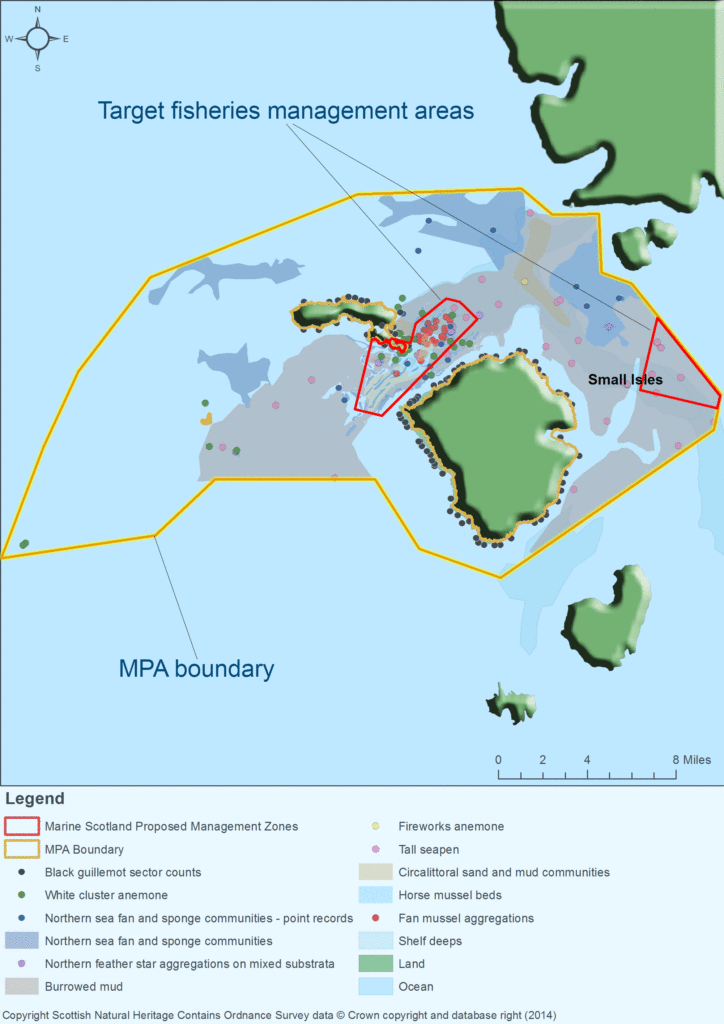This case study illustrates why the emerging management for Scotland’s new nature conservation MPAs looks likely to fall short of delivering adequate protection of the Small Isles MPA.
LINK members fully support the Small Isles possible MPA, recently designated for the conservation of a number of features[1], all of which are key components in the marine ecosystem of western Scotland. Many of these features have declined as a result of impacts from activities such as fishing, and their populations are of concern or are in critical condition.
Target areas for management[2] published by Marine Scotland have outlined zones in which bottom-towed mobile fishing gear is prohibited, a site-wide vessel capacity restriction and a prohibition of set nets within 2km of the Rum and Canna shore (to protect black guillemot colonies). As described by SNH, the features selected for protection within the MPA are benthic (seafloor) habitats and species, which are damaged by demersal mobile fishing gear. It is important that these activities are sufficiently restricted just to maintain the current status of the features. The damage to features from one trawl across the seabed can take decades to recover for some species and continued pressure from fishing will only result in further overall decline in biodiversity[3][4]. For features in critical condition, where population recovery is vital to ecosystem stability and function, it is therefore logical to adopt a precautionary approach and impose a total cessation of fishing activities, where the feature occurs, until population recovery becomes evident.
Of particular note in the Small Isles MPA are the fan mussel beds[5] which occur within the Sound of Canna – this type of aggregation is both rare and, possibly, unique, as it is the only known aggregation of this kind in Scotland. The fan mussel bed within the MPA is in good condition and has a conservation status of ‘conserve’, but the species as a whole is in critical condition and the potential for its long-term national recovery must be recognised. While bottom-towed mobile fishing gears are not used on the fan mussel bed due to the topography, it is important to ensure this aggregation is protection from dredge-disturbed sediment that might smother it, therefore appropriate management is still required. There is now ample scientific evidence for the effects of “spillover”[6][7] (increase in species number, biomass and overall diversity within a marine reserve spreads out into adjacent waters, providing ecological and socio-economic benefits in non-protected areas) and already these effects are becoming apparent within the Lamlash Bay No Take Zone, south east of the Isle of Arran.[8]
Other species that require more effective protection than is currently designated for the Small Isles MPA include the northern sea fan and the white cluster anemone, both of which are vulnerable to bottom-towed fishing gear[9]. Current target areas for fisheries management will afford protection to only half of the known occurrences of the northern sea fan and only a third of white cluster anemone records. It is also important to note that the Small Isles MPA is the only representative site of burrowed mud communities outside sea lochs on the west coast of Scotland and is considered by marine specialists to be the most nationally significant relic deep water mud habitat. We affirm that the management measures proposed for this site are not sufficient to achieve its conservation objectives – decline in feature condition will continue where features are still being impacted by fishing activities – and they should be augmented with greater consideration of the long-term national requirements for recovery of Scotland’s marine biodiversity.
It is important to note that the Small Isles was proposed as an MPA by the Small Isles Community Council (SICC) demonstrating the high value that local coastal communities place on their adjacent marine environment and indicates their commitment to protecting its health and biodiversity.
[1] http://www.snh.gov.uk/docs/A978513.pdf
[2] http://www.scotland.gov.uk/Resource/0044/00443028.pdf
[3] Foden, J., Rogers, S. I. & Jones, A. P. (2010). Recovery of UK seabed habitats from benthic fishing and aggregate extraction – towards a cumulative impact assessment. Marine Ecology Progress Series 411, 259-270.
[4] JM Hall-Spencer, PG Moore (2000) Scallop dredging has profound, long-term impacts on maerl habitats. ICES Journal of Marine Science: Journal du Conseil 57 (5), 1407-1415
[5] http://www.snh.gov.uk/docs/B988544.pdf
[6] Garry R. Russ and Angel C. Alcala (2011). Enhanced biodiversity beyond marine reserve boundaries: The cup spillith over. Ecological Applications 21:241–250
[7] Stobart, B., Warwick, R., González, C., Mallol, S., Díaz, D., Reñones, O. & Goñi, R. (2009). Long-term and spilloever effects of a marine protected area on an exploited fish community. Marine Ecology Progress Series, 384, 47-60
[8] Howarth, L., Wood, H. L, Turner, A. P. & Beukers-Stewart, B. D. (2011). Complex habitat boosts scallop recruitment in a fully protected marine reserve. Marine biology, 158, 1767-1780
[9] http://www.marine.scotland.gov.uk/FEAST

